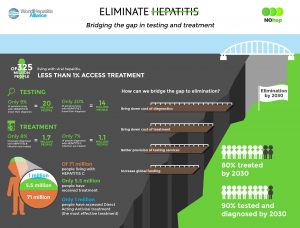By Professor Mark Thursz, Professor of Hepatology within the Department of Surgery and Cancer, Imperial College London
 Five viruses, hepatitis A – E, specifically infect the liver and cause acute hepatitis or chronic hepatitis.
Five viruses, hepatitis A – E, specifically infect the liver and cause acute hepatitis or chronic hepatitis.
Over 350 million people worldwide are chronically infected and are therefore at risk of cirrhosis, liver failure and liver cancer. Hepatitis B and Hepatitis C virus are together responsible for over a million deaths per year. The majority of infections and deaths related to these viruses occur in low and middle income countries. In 2010 the United Nations World Health Assembly passed a resolution which recognised the burden of disease imposed by these viruses and initiated a public health response to viral hepatitis which included the inception of World Hepatitis Day.
Chronic viral hepatitis infections rarely cause any symptoms or signs of the disease and therefore patients do not seek help until the final stages of disease when treatment is usually futile. However, if the infections are picked up early then they can be treated (Hepatitis B) or cured (Hepatitis C) in the majority of cases. It is therefore vital that people with viral hepatitis infection are diagnosed in good time which requires active case-finding or screening. Our work in West Africa demonstrated that screening for infection in the community is feasible, acceptable to the public and cost effective.
Last year the World Health Organisation set some ambitious targets towards the elimination of viral hepatitis with a 65% reduction in mortality and 90% reduction in new infections by 2030. In order to achieve these targets, every country in the world needs to strengthen national plans to address these infections. Coverage of the vaccination for Hepatitis B needs to be improved, systems for preventing mother to child transmission need to be implemented in many countries in sub-Saharan Africa where they do not currently exist. Infection control methods need to be strengthened to prevent transmission of hepatitis C which is frequently spread by medical and dental staff in low and middle income countries whereas opiate substitution and needle exchange services need to be strengthened in high income countries where intravenous drug use is an important mode of transmission. Even when all of these preventive strategies are put in place the only way in which the mortality from viral hepatitis can be controlled in a reasonable timeframe is to go out and diagnose the infections. The benefit of World Hepatitis Day is that it raised awareness around hepatitis viruses. Let’s hope awareness translates into higher rates of diagnosis.
